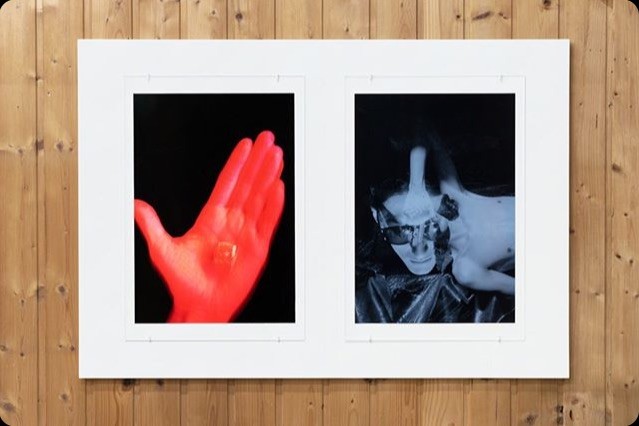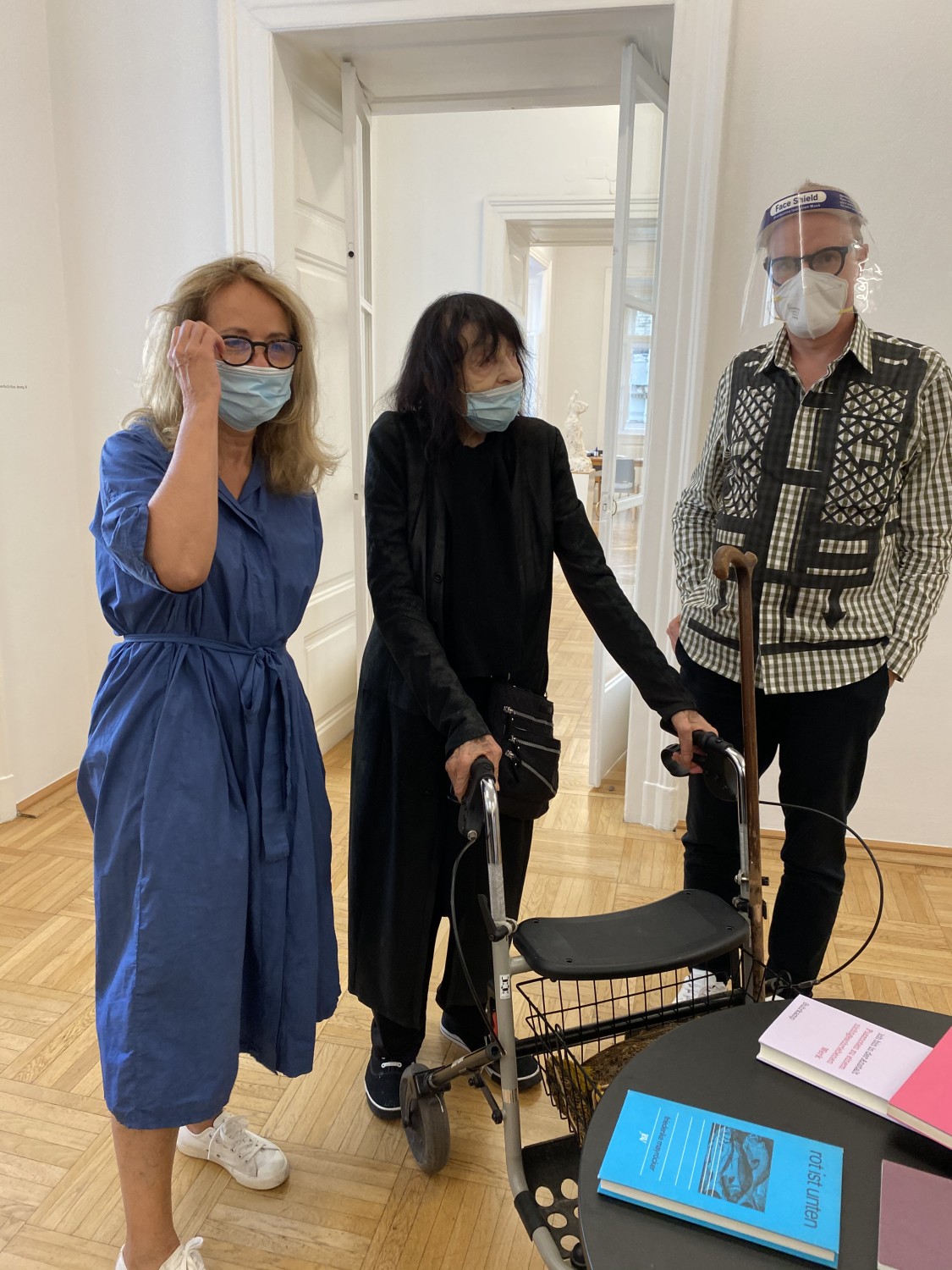
BEHIND THE SCENES:
GALERIE NÄCHST ST. STEPHAN ROSEMARIE SCHWARZWÄLDER, VIENNA
Friederike Mayröcker, Curator Hans Ulrich Obrist – until 10 Oct
Schutzgeister/Guardian Spirits
September 24th 2020
Part I
On the road. Have not flown since March; decamped to Paris mid summer, but like many I have flown weekly for three decades to Art Fairs, Openings, Studio Visits, to see clients, like getting on a school bus after a while. Not anymore.
A trip to Vienna in March was cancelled. I heard Schwarzwälder’s voice three weeks ago and knew it was time to move. Empty airports and plane. Before I knew it I was at this remarkable opening (everyone masked) for a poet I didn’t know, but now do. (So much for my knowledge of the post-War Austrian literary scene).
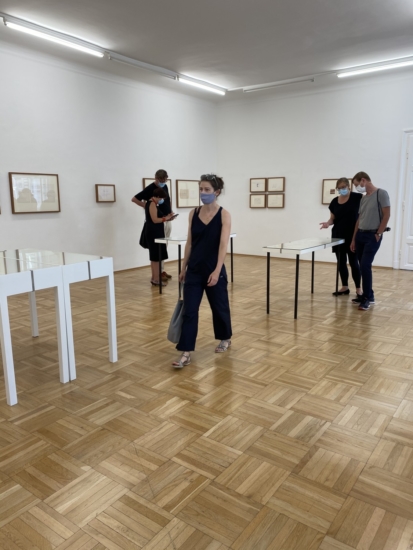
Mayröcker is a historic poet and writer who also makes drawings; a delicate way to ease back into looking at art after months of hiatus. The opening evening intense still-summer heat, masks, tables overflow with her numerous publications; I am dazed by her celebrity and determination. Obrist makes a museum show. It is unexpected and timely. “There is no certainty anywhere, there is only hope,” the artist’s words on the press release.
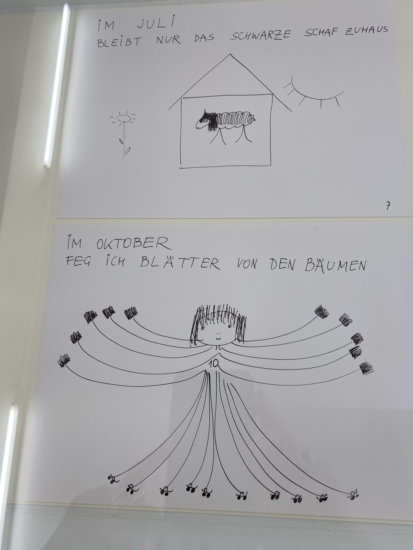

This un-emphatic female gesture, a silent cloud of sensitivity, innocent, playful auto- fictions as works on paper. The exhibition includes pencil drawings in vitrines and on the walls; a room of publications. Thoughts jump to other artists whose kinship I recognize here, Louise Bourgeois first of all, or Niki de Saint Phalle, though maybe I am tracing a path through certain discomforts that send artists into territories of child-like illustration. Not knowing her poetry I am caught by the drawings as a language of their own. She writes,
“I live in pictures. I see everything in pictures, my complete past, memories are pictures. I transform pictures into language by climbing into the picture. I walk into it until it becomes language.”
Part II
Want to share with you Hans Ulrich Obrist’s words on this exhibition. “When I first met Maria Lassnig in 1985, she told me of her passion for Mayrocker’s literary works. She showed me Rosengarten (Rose Garden), the artist’s book she and Mayrocker made together, poems with Lassnig’s illustrations, a combination that would leave a lasting impression on me. Lassnig proceeded to read to me from this book. The encounter when I was 17, thus found me emerged in a wonderful conversation about literature and art, how the two interact. ……It is thanks to Lassnig that I discovered Mayröcker’s works, and she is one of the few writers whose works I have read almost entirely.
I always wanted to meet her in person, and it was Lassnig who made this possible. In the many decades of my friendship with Lassnig, it became a kind of ritual for me to visit her whenever I was in Vienna. During one of these visits, when Lassnig’s life was near its end after 95 years, she turned to me and asked worriedly: ”What will you do in Vienna when I am gone?” So during our very last visit, she suggested that I meet her good friend Friederike Mayröcker.
Mayröcker firmly believes that writing reflects life and she describes melancholia as her driving force. She has devoted her entire life to writing and the intensity of her dedication has resulted in more than 100 books. At our first meeting at Café Sperl in Vienna I discovered that her work also includes drawings, created in a series for decades, depicting among other things, protective ghosts, that have lent this exhibition its name. We could really use their protective powers, especially in these difficult times.”
Part III
It is a rare moment to sit in the back room of a gallery after an opening is finished. Illicits a strong memory, this sensation, life before art fairs took all the oxygen out of these rooms. A back room moment. Soho in the ‘80s, all the action around a big table or the gallerist’s ample desk strewn with catalogues of recent museum shows, art periodicals open to reviews of their artists. Great collections root in these rooms, fatigue lowers all resistance and a glass of water, a cup of tea, a few grapes, almonds revive the spirit, your eyes see differently in the witching hours before dinner after a long day of looking and talking.
In this pause discussions begin again. Searching, humor filled, at ease in this place that belongs to gallerists, artists, museum directors and visitors from abroad. Schwarzwälder’s back room is a well-kept secret. Worth a trip to Vienna for a few moments of deep pleasure here. I very much wish you all have this experience too when travel is less complicated.
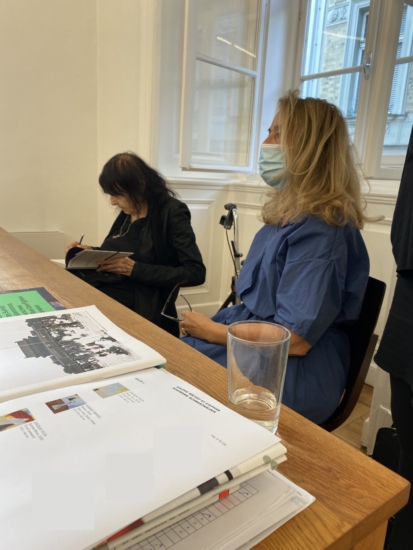
I took photos because it is like that. Quiet, thoughtful as if we are harvesting the spirits from Mayröcker’s exhibition and letting them surround us. Here you see Mayröcker, Schwarzwälder, on one side of the table resting behind closed doors, while art historian, museum director, Robert Fleck speaks with artist Jongsuk Yoon and HUO across the table, about the works filling the office walls.

Large vibrant paintings, capture Yoon’s ability to marry animated abstract forms and colors in a hushed but physical presences.


A recent monograph is passed from one person to another. It is a rare moment two women artists in the back room, their works couldn’t be more different from one another. But here at this table it feels like a magic, almost alchemical moment of relief, just getting to this place where the oxygen has not been sucked out of the room. Instead seeds are planted without the least effort as art continues its transformative power.
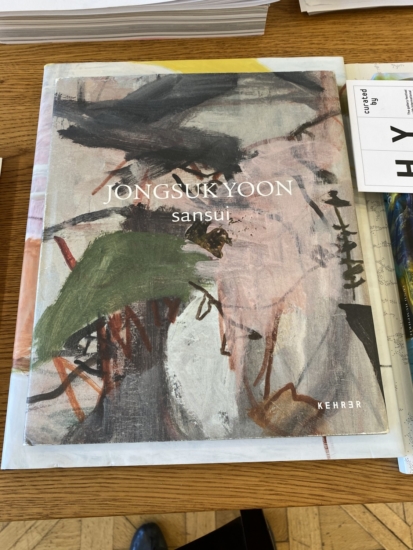
Part IV
As the early evening accelerates we take a short swing through some of the exhibitions that are part of the gallery weekend, a city-wide festival with international curators in Vienna, HYBRIDS closes this weekend. Wandering with facemasks is not an optimal way to look at art, but in this moment the mind tries to imagine they are not under the eyes fogging one’s specs. Two quick highlights thanks to pre-dinner stops with HUO.
Shout-out to Christine Konig Gallery with a curated presentation by Marina Fokidis WIR. Ein Hubrid im Werden that included memorable glimpses of Jimmie Durham, Peter Friedl (we don’t see his work enough), and Nancy Spero among others.
Then Exile gallery exchanges its sign for red neon which invites you to consider Julius Pristauz’s Untitled (Molly’s House); the reference to bars in 19th century
England where the spectrum of LGBTQ were invited to feel as if at home. The wood paneled two floor group show of 15 artists is filled with gender reflexive works in a wild and incandescent spectrum with a wide variety of medium; there are things to discover in this selection, especially two works by recent Kunstakademie Dusseldorf graduate, Berlin based Luki van der Gracht which pierce the subject of emotional discomfort seen through young eyes. This is a mix of poetry and photography in a practice worth keeping track of.
